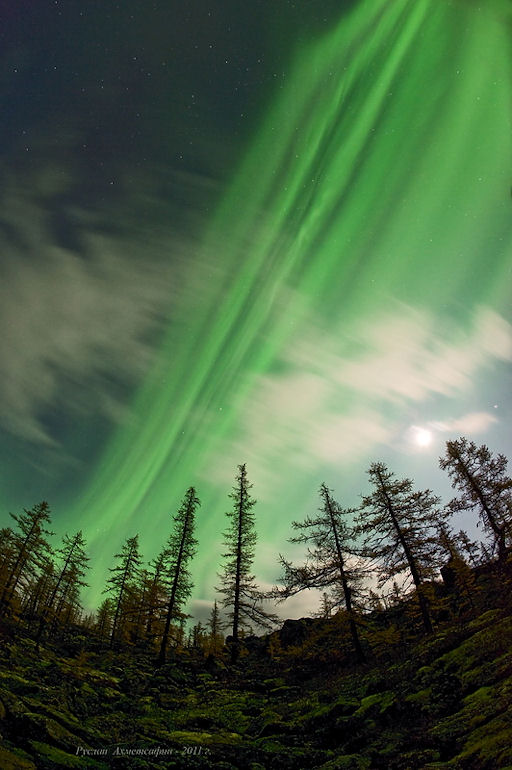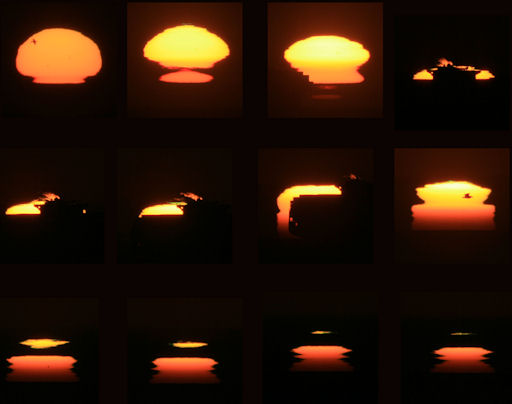Turn your cell phone into a field-tested satellite tracker. Works for Android and iPhone. | | |
REENTRY ALERT: NASA reports that UARS, an atmospheric research satellite the size of a small bus, will re-enter Earth's atmosphere on Sept. 23, plus or minus one day. Not all of the spectacularly-disintegrating spacecraft will burn up in the atmosphere; debris could be scattered along a ground track some 500 miles long. Because of the rapid evolution of UARS's decaying orbit, the location of the debris zone is not yet known. A NASA risk assessment places the odds of a human casualty at 1:3200. For last-chance sightings of UARS, check the Simple Satellite Tracker or download the Satellite Flybys app for your smartphone.
WEEKEND AURORAS: A coronal mass ejection (CME) hit Earth's magnetic field on Sept 17th, sparking a moderate geomagnetic storm (Kp=6) and auroras around the Arctic Circle. The view from Siberia was exquisite:

"I took the picture using my Nikon D3 digital camera," says photographer Ruslan Ahmetsafin of Aykhal, Siberia. "The sky was full of green."
Reverberations from the CME impact have subsided. NOAA forecasters estimate a less than 1% chance of geomagnetic storms tonight. Aurora alerts: text, voice.
more weekend images: from Michael Kunze flying 30,000 ft over Greenland; from Chad Blakley of Abisko National Park, Sweden; from Joseph Bradley of Whitehorse, Yukon; from B.Art Braafhart of Salla, Finnish-Lapland; from Laffen Jensen of Stjorda, Trondheim, Norway; from John Dean of Dexter, Alaska
UPDATED: September 2011 Aurora Gallery
[previous Septembers: 2010, 2009, 2008, 2007, 2006, 2005, 2004]
WILD AND CRAZY SUNSET: "Last night I decided to hunt for a green flash," says photographer Mila Zinkova of San Francisco. "So I took my camera to the beach to watch the sunset." She found what she was looking for--and much more. Scan the snapshots in full size, then read the description below:

"I was watching the the mock-miraged sun slowly descend toward the horizon when suddenly it was eclipsed," says Zinkova. "A big ship was passing just in front of the sun. A distorted fragment of sun rose above the ship like a solar prominence and just below it there was a green flash! After the ship passed I observed a few more green flashes. I also captured sunspots in some frames--not to be mistaken with birds."
The California Coast is a good place to see these things. The combination of cold offshore ocean current and warm winds from the land create temperature inversions that bend the sun’s rays to form fantastic mirages and green flashes. Birds, ships, and sunspots add their own distinctive contribution to the wild-and-craziness. More of Zinkova's California sunset-shots may be found here.
Potentially Hazardous Asteroids (
PHAs) are space rocks larger than approximately 100m that can come closer to Earth than 0.05 AU. None of the known PHAs is on a collision course with our planet, although astronomers are finding
new ones all the time.
On September 19, 2011 there were 1244 potentially hazardous asteroids.
Notes: LD means "Lunar Distance." 1 LD = 384,401 km, the distance between Earth and the Moon. 1 LD also equals 0.00256 AU. MAG is the visual magnitude of the asteroid on the date of closest approach. | | The official U.S. government space weather bureau |
| | The first place to look for information about sundogs, pillars, rainbows and related phenomena. |
| | Researchers call it a "Hubble for the sun." SDO is the most advanced solar observatory ever. |
| | 3D views of the sun from NASA's Solar and Terrestrial Relations Observatory |
| | Realtime and archival images of the Sun from SOHO. |
| | from the NOAA Space Environment Center |
| | the underlying science of space weather |
| | for out-of-this-world printing and graphics |

